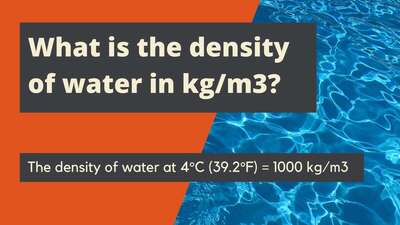Density of water g/cm3
Density of water g/cm3 is one of the commonly used versions of water density at all. Do you also want to know what the value of the density of water in g/cm3 is? Are you wondering how the water density changes in different temperatures? Here you will find the answers to all these questions, so keep reading.
What is the density of water?
First things first. To talk about the density of water g/cm3, it is needed to know what the water density exactly is. Of course, probably most of you know more or less about it. But we want to make you know more, not less.
So what is the density of water? To explain it clearly, it is needed to focus on the units of density. Have you ever noticed that the units of density are composed of 2 different units? There is not such a particular unit dedicated for density, which has its own name. The density units are always made with the use of the mass unit and the volume unit.
Have a look:
The density unit = the unit of mass / the unit of volume
So the simplest definition of water density is just the weight of water per the volume of water. Remember that the density is closely related to the temperature too. When the temperature changes, the water density also changes.
The value of the density of water in g/cm3
The base value of the density of water g/cm3 is just 1. The result you can see also down below:
The density of water = 1 g/cm3
It is the most commonly known value of water density in g/cm3, but you have to remember that it’s not the only one.
This value is exact only at 4 degrees Celsius (39.2 degrees Fahrenheit). At other temperatures, the value of the density of water in g/cm3 is only approximately equal to 1.
What are the exact values of water density in other temperatures? The answer you will find in the next paragraph, so keep reading.
How does the temperature impact on the density of water g/cm3?
What is the impact of the temperature on water density in g/cm3? How does the value of the density of water g/cm3 change?
We want to focus on 2 temperature values mostly. First, the temperature in which water freezes. Second, the temperature in which the water boils.
As you may know, the water freezing point is 0 degrees Celsius (32 degrees Fahrenheit). What is the density of water g/cm3 at 0°C? The answer is 0.99987 g/cm3.
The density of water at 0°C: 0.99987 g/cm3.
In turn, the water boiling point is 100 degrees Celsius (212 degrees Fahrenheit). What is the density of water g/cm3 at 100°C? The water density is equal to 0.95865 g/cm3 then.
The density of water at 100°C: 0.95865 g/cm3.
As you can see, the density of water is bigger at 0 degrees Celsius than at 100 degrees Celsius. But in both cases the water density is not equal to 1 g/cm3.
Of course, in other temperatures the density of water g/cm3 also changes. We gathered few more examples in a table down below, let’s see:
| Temperature – °C | Density – g/cm3 |
| -20 | 0.99355 |
| -10 | 0.99817 |
| 0 | 0.99987 |
| 4 | 1.00000 |
| 10 | 0.99975 |
| 20 | 0.99823 |
| 60 | 0.98338 |
| 100 | 0.95865 |
As you can see, the density of water is coming bigger when the temperature decreases. It takes place till the temperature is equal 4 degrees Celsius. It is the water density maximum point. Then, when the temperature decreases again, the density is coming smaller.
Why is the density of water maximum at 4 degrees Celsius?
The density of water has its maximum at 4 degrees Celsius, because of 2 physical effects occurring. What are they?
First of them is slowing down water molecules. They start to slow down when the temperature of water starts to decrease. In other words, the lower the temperature, the slower molecules move.
Second of them is forming clusters. They start to form at 4 degrees Celsius. The clusters between molecules make them be further apart.
As you can see, the 2 different effects work together at one time, but the cluster forming is the bigger one. That’s why at 4 degrees Celsius the density of water increases as much.We hope that now you finally know what the density of water is and what its values are in g/cm3 in different temperatures. If you are interested in water density in other units, check also our other articles.









